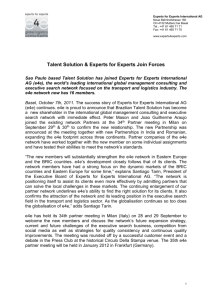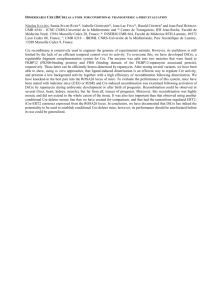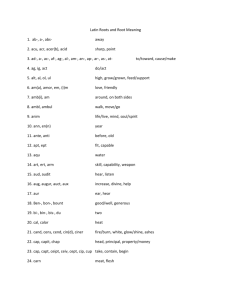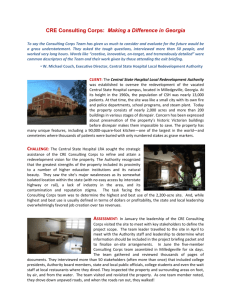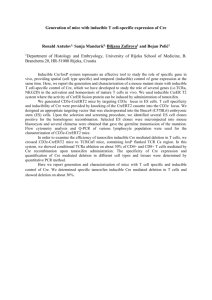Document 10465275
advertisement
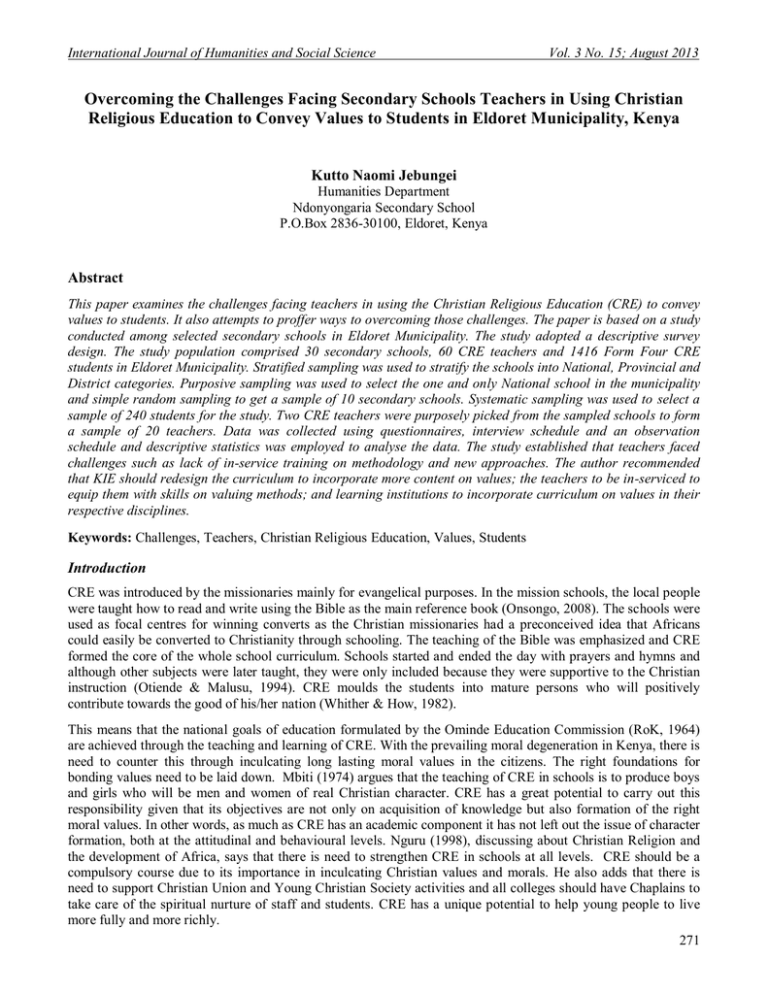
International Journal of Humanities and Social Science Vol. 3 No. 15; August 2013 Overcoming the Challenges Facing Secondary Schools Teachers in Using Christian Religious Education to Convey Values to Students in Eldoret Municipality, Kenya Kutto Naomi Jebungei Humanities Department Ndonyongaria Secondary School P.O.Box 2836-30100, Eldoret, Kenya Abstract This paper examines the challenges facing teachers in using the Christian Religious Education (CRE) to convey values to students. It also attempts to proffer ways to overcoming those challenges. The paper is based on a study conducted among selected secondary schools in Eldoret Municipality. The study adopted a descriptive survey design. The study population comprised 30 secondary schools, 60 CRE teachers and 1416 Form Four CRE students in Eldoret Municipality. Stratified sampling was used to stratify the schools into National, Provincial and District categories. Purposive sampling was used to select the one and only National school in the municipality and simple random sampling to get a sample of 10 secondary schools. Systematic sampling was used to select a sample of 240 students for the study. Two CRE teachers were purposely picked from the sampled schools to form a sample of 20 teachers. Data was collected using questionnaires, interview schedule and an observation schedule and descriptive statistics was employed to analyse the data. The study established that teachers faced challenges such as lack of in-service training on methodology and new approaches. The author recommended that KIE should redesign the curriculum to incorporate more content on values; the teachers to be in-serviced to equip them with skills on valuing methods; and learning institutions to incorporate curriculum on values in their respective disciplines. Keywords: Challenges, Teachers, Christian Religious Education, Values, Students Introduction CRE was introduced by the missionaries mainly for evangelical purposes. In the mission schools, the local people were taught how to read and write using the Bible as the main reference book (Onsongo, 2008). The schools were used as focal centres for winning converts as the Christian missionaries had a preconceived idea that Africans could easily be converted to Christianity through schooling. The teaching of the Bible was emphasized and CRE formed the core of the whole school curriculum. Schools started and ended the day with prayers and hymns and although other subjects were later taught, they were only included because they were supportive to the Christian instruction (Otiende & Malusu, 1994). CRE moulds the students into mature persons who will positively contribute towards the good of his/her nation (Whither & How, 1982). This means that the national goals of education formulated by the Ominde Education Commission (RoK, 1964) are achieved through the teaching and learning of CRE. With the prevailing moral degeneration in Kenya, there is need to counter this through inculcating long lasting moral values in the citizens. The right foundations for bonding values need to be laid down. Mbiti (1974) argues that the teaching of CRE in schools is to produce boys and girls who will be men and women of real Christian character. CRE has a great potential to carry out this responsibility given that its objectives are not only on acquisition of knowledge but also formation of the right moral values. In other words, as much as CRE has an academic component it has not left out the issue of character formation, both at the attitudinal and behavioural levels. Nguru (1998), discussing about Christian Religion and the development of Africa, says that there is need to strengthen CRE in schools at all levels. CRE should be a compulsory course due to its importance in inculcating Christian values and morals. He also adds that there is need to support Christian Union and Young Christian Society activities and all colleges should have Chaplains to take care of the spiritual nurture of staff and students. CRE has a unique potential to help young people to live more fully and more richly. 271 © Center for Promoting Ideas, USA www.ijhssnet.com The knowledge and understanding acquired in other subjects can be brought together in the CRE class to enable students to develop a holistic vision of life. CRE is not only consistent with the essential purposes of liberal learning but no other subject is likely to contribute to the humane, spiritual and civilizing purposes which characterize the pursuit of that learning. The subject has unique goals of improving moral values of its recipients. The teaching of CRE in Kenya has been justified on educational grounds as contributing to the fulfilment of national educational goals. Otunga (2010), while discussing on the dilemma of curriculum relevance in Kenya, strongly emphasizes that a relevant curriculum should focus on the achievement of national development goals. This need for relevance is reflected in the CRE syllabus. The first of these national education goals is that of national unity which is fulfilled through CRE by promoting positive attitudes of mutual respect which enable the youth to live together in harmony. Emphasis on content relevant to life ensures social and economic national development. Individual development and self fulfilment is achieved by fostering sound moral and religious values in order to help the youths to grow up into self disciplined citizens. The CRE curriculum has the capacity to develop the cognitive, psychomotor and affective aspects in the individual to the highest level. CRE advocates for a common syllabus for Christian students at all schools with courses based on their common Christian heritage to ensure that there is social equality. CRE enables the youth to respect and appreciate other peoples’ cultures and this has been facilitated through the incorporation of African Religious Heritage content in the syllabus. This area of study is rich in moral values making the subject more relevant to the contemporary society. On international consciousness CRE teaches courses on contemporary Christian living in an effort to help the youth in enhancing appreciation of the current social, political, religious, and economic issues affecting the world today. Such contemporary issues include globalization, technological development, environmental degradation, drug and substance abuse, terrorism, cultic worship and human trafficking. A relevantly crafted curriculum has capacity to address these issues and problems. CRE occupies a key position in the 8-4-4 curriculum by enabling the learner to integrate all subjects of the curriculum into a more mature view of him/herself, his/her relationship with environment, both physical and cultural, his/her fellowmen and God his/her creator. Groenewegen (1993) observes that many parents in Kenya insist that their children must take CRE so that they learn to be of good moral behaviour. Groenewegen (ibid.) adds that CRE facilitates the acquisition of moral disposition, that is, knowledge, skills and attitudes of ethical significance and that the subject is highly needed because of the increasing cases of socially and morally irresponsible behaviour of many individuals. Similarly, Wepukhulu (2001) points out that the kind of knowledge acquired in CRE is important because it should be internalized in the formation of one’s character and consequently be applied in problem solving. However, not all students consider the subject for its moral teachings since some do it for the purpose of passing examinations. This is according to a study done by Chemutai (2008) on influence of attitude to CRE on students’ performance. The use of Life Approach in CRE to Enhance Acquisition of Values In the teaching of CRE, the teacher is expected to apply appropriate teaching methods based on the learners’ experiences. The teacher should be equipped with relevant skills to enable him/her to deliver the subject contents effectively through selection of methods which aim at making teaching learner-centred and to bring about positive behaviour change. The teacher should use creativity and innovativeness in whatever methods or techniques to help promote and sustain the positive change. In her study on the use of the life approach method in the teaching of CRE in secondary schools, Onsongo (2001) defined life approach as starting to teach with the real and concrete and the present situation of the learners, and letting them arrive at a religious understanding of those experiences. The approach implies that God speaks to people through their situations and experience and emphasizes the use of the learners’ day-to-day experiences as the basis of teaching CRE. Religious beliefs cannot be taught as if they were facts; they are by nature experiential (Grimmit, 1973). Findings from developmental psychology presuppose a developmental approach in all teaching. This calls for emphasis on the students own experiences, needs and interests and the need to encourage the learners to look more deeply into their feelings, acts, and experience, and to express what they discover in everyday language. The pluralistic and materialistic nature of the present-society cannot allow for the use of traditional methods of teaching religion. To some extent, religion has become a private affair, so the approach in teaching it should be one that can help the students to make his/her own free choice, particularly in matters relating to value acquisition (Onsongo, 2008). 272 International Journal of Humanities and Social Science Vol. 3 No. 15; August 2013 Stages in the use of the Life Approach Walaba (2008) outlines a lesson plan format that has the following steps which a teacher using life approach may follow, for example: Topic: Christian Teaching on Money, Wealth and Poverty in the Old Testament Specific Objectives: By the end of the lesson the learner should be able to: Cognitive: Explain Christian teaching on money, wealth and poverty in the O.T. Attitudinal: Appreciate and apply the teachings learnt in their daily lives. i) Human Experience In this stage, the lesson begins with the teacher involving the learners in reflecting on their day-to-day experiences related to the subject matter. Its purpose is to arouse the learners’ interest, attention and to stimulate his/her imagination. This could be a scenario, questions, demonstration, interesting stories or even drama which is relevant to the lesson and to the learner’s life. The teacher is expected to show how God is revealed in the experience. ii) The Biblical Experience The teacher introduces the relevant text from the Bible, and then guides the learners to read the references where applicable while giving appropriate explanation. iii) Explanation The teacher explains the main points by use of various teaching aids to make the lesson more real, lively and interesting. Methods such as discussion, question and answer, note making, lecture can be used for in-depth comprehension of knowledge of the content necessary for application and choice of values. iv) Application and Response At this stage, the teacher tries to show the relevance of the content to the learners’ lives and assesses whether the attitudinal objective has been achieved or not. The teacher provides the learners with an opportunity to react and respond to the message of the lesson. Since life approach focuses on critical thinking, it encourages interactive and participatory learning. Lulley (2009) observes that the teacher is required to help or stimulate the student to reflect, analyze and synthesize information and eventually apply it to their own life. Appropriate methods used are those that enhance acquisition of values such as small group discussion and valuing methods (value clarification, self exploratory, value sheet and group inquiry). Conclusion This is the summary of what has been covered and the teacher can ask oral questions based on the content to help consolidate the lesson or give a brief overview of what has been covered while putting emphasis on the significance of values acquired in day-to-day life. Statement of the Problem It is becoming increasingly evident that a discrepancy exists between what students learn in CRE and how they behave. Core values such as respect, responsibility, honesty, chastity hard work and tolerance do not seem to have been internalized by the students. CRE consumers are expected to use the knowledge and skills gained to bring positive change in behaviour but the subject seem to be lacking competence in helping students attain the same. The teaching and learning of CRE is meant to not only mould one spiritually but also to contribute positively to transformation of self and the society as a whole (Gichaga & Kerre, 2004). Could this suggest that the approaches to values that have been so widely used in the past have been less effective? Why must teachers see their role only as imparting knowledge into the mind of the student? Why can’t a role be defined that would help him or her identify the problem, understand, analyze and try to find solutions on their own? Why can’t teachers learn to spend some of their time helping students understand what the bewildering array of beliefs and attitudes that saturate our modern life are all about and which suits him best? The paper sought to find answers to these questions in an attempt to move toward value clarity. 273 © Center for Promoting Ideas, USA www.ijhssnet.com This was hoped to bring a clear understanding between teaching values and teaching for values (valuing) through the CRE curriculum. Challenges of Using CRE to Enhance Values The teaching and learning of CRE in secondary school reveals that the subject has continued to be less prominent among students in secondary schools. Eshiwani (1992), on the quality of secondary education in Kenya, notes that the challenge associated with the teaching of subjects like CRE is perceived by learners as having a minimal contribution to the job-market. This is compounded by the fact that the subject is not a prerequisite for entry to highly ranked professional courses like medicine, engineering, law and computer science. Many students are opting for science subjects. A proposal by the Ministry of Higher Education that the government would in the future only sponsor university courses that are directly relevant to the attainment of the Vision 2030 economic development, only served to worsen the status of art-related courses. This proposal ignores the important contribution of the art subjects in realizing the same goals and the fact that teachers are required to lead the way to attain the Millennium Development Goals (MDG). Some people believe that CRE is an easy subject for students to pass and offers no job prospects except becoming preachers or teachers of CRE (Chemutai, 2008). This negative feeling towards the subject has also affected CRE teachers in that some shy away from the subject while others feel it is a subject for the female (Christian Educator, 1993, December). This requires a reexamination of the subject in order to establish what has tainted its image. A study by Ogula (1994) to examine the attitude of parents, primary teachers and pupils in Kenya towards Social Studies curriculum in relation to pupils’ achievement has found out that most teachers used the lecture method which made lessons boring making students develop a negative attitude towards the subject. This poses a challenge to the teaching and learning process of any subject and particularly CRE. Nzomo (2011) urges teachers to improve their competence through training since it helps one develop skills, character and ultimately better their profession. Nzomo (ibid.), however, notes that basic teacher training is weak in Kenya because they are not re-trained and targeted training is very limited. There is thus need to organize in-service courses for CRE teachers in order to boost their morale and improve their teaching skills. The lack of concern by the Ministry of Education portrays the fact that it is not positive towards the subject. It is keener on science subjects and this is reflected through the in-service courses for science and mathematics teachers (SMASSE) and increment of their salary while the humanities teachers, CRE included, were left out. Simatwa (The Standard, 2011, January 19) observes that motivated teachers often increase chances of students excelling in national exams and pursuing courses of choice in university. Goble (1977) has reported that in-service training is necessary to remedy deficiency that teachers have discovered in their professional skills and in some specialized skills to keep pace with the changing demands of a given curriculum. Ondiek (1995) also adds that if teachers are to take full responsibility of their duties, then they should be prepared beyond mere planning of a series of lessons and be able to justify the input and value added to the learner. Another challenge facing the use of CRE to convey values is the negative influence from print and electronic media and the internet which many youths have been hooked to. These channels have introduced the young people to foreign, conflicting values and immoral practices. There is a worrying trend of increasing cases of addiction to internet pornography in Kenya among children and youth through mobiles phones and computers. The situation is worsened by the general moral decadence in the society evidenced by cases of robbery, violence, rape and defiling, murder, corruption even among top government officials such as the Goldenberg, Anglo leasing and the Nairobi City Council cemetery scams. Ndarwa (2007) makes similar observations in her study on the role of CRE in students’ moral development. Limitations of the Study The major limitation of the study was that its findings may not be generalized to cover the entire country since the population sample was drawn from only one urban region, Eldoret Municipality. The study confided itself to Form 4 CRE students only whereas CRE is taught from Form One to Form Four in Kenyan secondary schools. The views would thus only be representative of the Form 4 class. This paper mainly focuses on the challenges teachers face in using CRE to enhance values in the students; ther could be other factors influencing student’s acquisition of values, such as, religious background, school sponsor and the teachers’ personality. 274 International Journal of Humanities and Social Science Vol. 3 No. 15; August 2013 While it is recognized that a country wide survey would be preferred to a regional one, the study provides a framework on which similar studies could be replicated in other regions. Materials and Methods The study was carried out in Eldoret Municipality which covers a small portion of Wareng, Eldoret East and West Districts in Uasin Gishu County in Kenya. Eldoret town lies between latitude 00’30’North and longitude 35’16’ East of altitude 2085m above sea level. The study adopted a descriptive survey design. The target population comprised all CRE teachers and all form four CRE students drawn from all thirty secondary schools in Eldoret Municipality. There were 60 CRE teachers and 1416 form four CRE students. The author used both probability and non-probability sampling techniques in the study. Stratified sampling technique was used categorize the schools into national, provincial and district schools. Purposive sampling technique was used to select the only national school in the study area. Further, simple random sampling technique was used to pick 5 provincial schools out of the 16 schools and 4 district schools out of 13 schools. A total of ten (10) schools were eventually picked with a total number of 60 CRE teachers and 749 form four CRE students. In each of the ten schools, purposive sampling was used to pick 2 CRE teachers from each school totalling 20. Those picked must have handled a form four class and are currently engaged in teaching of CRE in their schools. The author further employed systematic sampling technique to proportionately determine the eventual number of student respondents from each school. The author developed a sample frame from each school, based on student admission numbers. Every 3rd student was picked as a respondent to the instrument adding up to a total of 240 student respondents. A sample size of 260 respondents participated in the study. The data was obtained by use of questionnaires, interview schedule and an observation schedule. It was then coded by assigning numerical values to each response and entered into the computer. Statistical Package for Social Sciences (SPSS) and Ms Excel were used to aid in data analysis. The questionnaires had closed-ended items and each statement was rated on a 5point Likert scale ranging from strongly agree (5) to strongly disagree (1). The response to various statements were scored in such a way that a response indicative of the most favourable attitude was given the highest score of 5 and that with the most unfavourable attitude was given the lowest score of 1. The total score of each respondent was obtained by adding the scores for separate statements. Data was analyzed using descriptive statistics and presented using frequency and percentage tables. Results Challenges Facing Teachers in Using CRE to Enhance Values One of the objectives of the study was to explore the challenges facing teachers in using CRE to enhance values amongst students in schools in order to seek ways of alleviating them. In order to identify the challenges, the study sought opinions from CRE teachers on what they perceived as factors that militated against the implementation of values acquisition through CRE. The findings are as presented in Table 1. Table 1: Teachers’ Views on the Challenges inhibiting the use of CRE to enhance values Challenges Significant N % 18 90 12 60 16 80 Emphasis on science subjects Moral degradation in society Failure to attend seminars, workshops, refresher courses Pressure to complete syllabus for exam 12 purposes/wide syllabus Negative media/internet influence 15 Negative attitude towards CRE 17 Undecided N % 2 10 - Not significant N % 2 10 6 30 4 20 Total N % 20 100 20 100 20 100 60 1 10 7 35 20 100 75 85 2 10 - 5 3 25 15 20 100 20 100 From Table 1, it can be deduced that there are factors that militate against the implementation of values acquisition through CRE subject. 275 © Center for Promoting Ideas, USA www.ijhssnet.com Emphasis on Science Subjects The teachers noted that in most of the schools, more emphasis was placed on science subjects at the expense of humanities under which CRE subject falls. As shown in the findings, majority of the respondents (90%) asserted that a lot of emphasis is placed on science and mathematics subjects. Moral Degradation in the Society As found in the study, 60% of the teachers noted that moral degradation in society posed difficulty in using the subject to convey values. This could be attributed to the fact that students are greatly influenced by the social evils going on in the society since they are part and parcel of the society. The direct relevance of the subject to the day to day life of the students could not be easily established. Failure to attend Seminars, Workshops Failure to attend seminars, workshops, refresher courses was also noted as a challenge by the teachers who participated in the study. Out of the total number of respondents, 80% indicated that there are no such opportunities for the CRE teachers. This implies lack of support from the educational managers to the CRE teachers. This impacts negatively on the teaching and learning of the subject and hence becomes a hindrance to acquisition of values by students since the in-services provide opportunities for new skills and knowledge on content and methodology. Wide Syllabus and Exam Pressure From the findings of the study 60% of the respondents strongly agreed or agreed that the current syllabus is very wide and that they were under pressure to complete the syllabus for exam purposes which concentrates more on the cognitive aspect of learning at the expense of value acquisition. Negative Media/Internet Influence As shown in the Table 1, 90% of the respondents noted the negative media and internet influence on the teaching and learning of the subject and more so on students’ acquisition of values. This is because the programmes both in print and electronic media offer totally different and conflicting set of values from those advocated for through the CRE subject. Students easily access the internet through mobile phones which exposes them to all sorts of materials some of which promote immoral and criminal activities. This poses a big challenge to teachers who have to deal with students in a state of confusion of values. General Negative Attitude towards CRE On whether or not the general negative attitude in their schools towards the subject was of significance the response was on the affirmative with 85% in agreement. This was further confirmed during the interview that the negative comments made by other members of staff concerning the subject, the low status accorded, lack of administrative support and bias towards science and other subjects had impacted negatively on the teachers’ efforts to enhance values in students. Notably, a few teachers (15%) reported during the interview that they received a lot of support from the administration in terms of teaching and learning resources, according the CRE subject a higher status just like other subjects and sponsoring the teachers for workshops and seminars. This, they noted, had improved the attitude and general performance of the subject. Discussion The study explored the challenges facing teachers in using CRE to enhance values amongst students in schools in order to seek ways of alleviating them. From the findings, the teachers raised factors which hinder their efforts and desire to assist students acquire values. Going by the data provided by the teachers, it is indicative that there is little or no emphasis on CRE in most of the schools despite the moral role of the subject in instilling values in students. Similar observation was made by Ndarwa (2007). There is need for the subject to be considered equally important just like the sciences and languages in schools. 276 International Journal of Humanities and Social Science Vol. 3 No. 15; August 2013 Moral degradation in the society has had a great influence on the students and teachers were in agreement that it is becoming increasingly difficult to mould students’ behaviour using CRE. This could be attributed to the fact that students belong to the society and the school is part of it. Secularization and the explosion of knowledge have turned the world into a global village and this makes religion to be irrelevant to the business of living (Onsongo, 2008). A significant number of teachers reported that they had hardly attended in-service courses, seminars and workshops for CRE teachers. These courses cultivate various skills with respect to students’ activities and teaching methods. There is need to organize refresher courses so that teachers can benefit from them and will equip them with new approaches and methodology on teaching of value. This concurs with Nzomo’s (2011) comments that teachers need to upgrade their teaching skills to keep up with demands of the fast changing society. The findings of the study are in line with those of Kiniale (2000) who asserts that the syllabus is too wide to be covered within the specified period. The study established that CRE teachers are under a lot of pressure to complete the syllabus for examination purposes. This poses a challenge to them since a lot of concentration will be put on the transmission of knowledge at the expense of the affective aspect of learning concerned with development of desirable attitudes and values. Such a situation is contradictory to the aim or goal of CRE which is geared towards holistic development of learners (Walaba, 2008). The findings indicated that the media/internet has had a negative influence on the student’s acquisition of values. The study also revealed that the learners access some materials which are not good for their moral development for instance fictitious movies and pornographic materials through the media and particularly the internet. These impact on them negatively not only in terms of concentration on academics but also on acquisition of values (Nyagrowa, 1997). On the general negative attitude towards CRE in their respective schools, a large number of teachers felt that this factor has negatively contributed to the effective use of the subject to enhance students’ acquisition of values. Negative comments made by other members of staff concerning the subject especially during assemblies and career choice forums have only served to demean its status and this attitude is likely to be passed on to the students. These findings concur with that of Kipkemboi (2009) in his study on challenges of moral development. Using the research instruments (questionnaire and interview schedule), the author sought views from the respondents on solutions to the challenges raised and on the future of CRE in the curriculum as a subject that conveys values. Teachers gave the following suggestions: i) ii) iii) iv) v) vi) The need for administrative support to CRE teachers in terms of provision of instructional materials, and incentives to CRE teachers. Emphasis on the importance of the CRE and making the subject compulsory. Organizing in-service/refresher courses, seminars and workshops for CRE teachers. Working together with other departments to instill values in students. Curriculum changes to incorporate training on approaches to values in training courses for CRE teachers. The need for varied and appropriate teaching methodologies. Conclusion and Recommendations As revealed in the study, CRE teachers in schools face many challenges in using the subject to enhance values in students. The challenges range from the lack of support in terms of in-service courses, negative attitude, overloaded syllabus, moral decay in society, over emphasis on science subjects, negative influence from print and electronic media that present conflicting values to the youth. There is need to seek for solutions to these obstacles so as to enable effective acquisition of values through the subject. Generally, the role of the school is not simply to make students accumulate knowledge, but rather mould them into a well cultured citizen.CRE can enhance development of values and attitudes if properly taught. Effective teaching of the subject is dependent on the teacher’s skills and perception within a particular situation since the syllabus only suggests ideas and general outlines. Value education, like poetry, is ‘caught’ rather than taught. It is indicative that the challenges facing the use of CRE to enhance student acquisition of values were real and surmountable. Solutions to these inadequacies however, ought to be addressed by all stakeholders because constraints touching on teacher preparation and attitudes towards the subject require the attention of the school management. 277 © Center for Promoting Ideas, USA www.ijhssnet.com References Christian Educator, CCEA (1996). Journal of Religious Education, 9(16). Chemutai, F. (2008). The Students Attitude Towards CRE and its Influence on Performance in School in Eldoret Municipality, Uasin Gishu District, Kenya (Unpublished M.Phil Thesis). Moi University, Eldoret. Eshiwani, G. S. (1992). The Quality of Secondary Education in Kenya. Nairobi: East African Educational Publishers. Gichaga, N. S., & Kerre, B. W. (2004). Secondary CRE Form Four Teachers Guide (2nd ed.). Nairobi: Kenya Literature Bureau. Goble, F., & Porter, J. (1977). The Changing Role of the Teacher: International Perspectives. Paris: UNESCO. Grimmit, M. (1973). What Can I Do In Religious Education? A Guide to New Approaches. London: MayhewMcCrimmon. Groenewegen, T. (1993). Subject Methods Religious Education. A Course Book for Teachers. Nairobi: Lectern Publication. Kipkemboi, M. (2009). Secondary School Teachers’ and Students Perception of the Challenges to Moral education in Uasin Gishu District (Unpublished M. Phil Thesis). Moi University, Eldoret. Lulley, S. (2009). The Teaching of African Traditional Religion Content in CRE in Secondary Schools of Marakwet District (Unpublished M.Phil Thesis). Moi University, Eldoret. Mbiti, D. M. (1974). Foundations of School Administration. Nairobi: Oxford University Press. Ndarwa, L. (2007). Students and Teachers Perception on the Role of CRE in Moral Development of Students. Central Division in Trans Nzoia District, Kenya (Unpublished M.Phil Thesis). Moi University, Eldoret. Nyagrowa, S. P. (1997). Laying the Foundation for Building Virtues in the face of Moral Deterioration in Kenya. Implications for the Teaching of CRE. Journal of Moral Education, 43: 32-44. Ondiek, P. (1995). Curriculum Development Alternatives in Educational Theory and Practice. Kisumu: Lake Publishers and Enterprises. Onsongo, J. K. (2008). Teaching Christian Religious Education in Secondary Schools: A Handbook for Teachers and Student-Teachers. Nairobi: Catholic University of East Africa. Onsongo, J. K. (2001). The Life Approach Method in Teaching Christian Religious Education in secondary schools. Retrieved on March, 23, 2011 from http.//www.fiuc.org…/eajoun1lifeap.php Otunga, R. N. (2010). Elements of Relevant Curriculum. 2010. Retrieved on March 26, 2011 fromhttp://cmslive.curriculum.edu.au Ogula, P. A. (1994). The Evaluation Experience of Primary and Secondary Education Projects in Kenya. The Board of Trustees of the Leland: Stanford Junior University Otiende, J.E., Wamahium, S.P., & Karagan, A.M. (1992). Education and development in Kenya: A historical perspective. Nairobi : Oxford University Press. Republic of Kenya (1964). The Ominde Commission Report. Nairobi: Government Printers. Sifuna, D.N. & Otiende, J. E. (1994). An introductory history of education (2nd ed.). Nairobi: Nairobi University Press. Simatwa. (2011, January 19). The Standard, Nairobi: Standard Group. Wepukhulu, R. (2001). Attitudes of the Christian Churches and Teachers in Bungoma District towards Social Education and Ethics as a discipline in Secondary Schools in Kenya (Unpublished Thesis). Moi University, Eldoret. Whither, & How, (1982). Kenya Catholic Education Policy Handbook. Nairobi: English Press. 278


